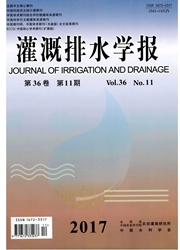

 中文摘要:
中文摘要:
阈值的合理选择是应用指示克里格法(Indicator Kriging,简写IK)进行风险评价的关键。以禹城市0~20 cm耕层土壤盐分空间变异性为例,利用GIS和GS+探讨了不同土壤盐分阈值下,盐分的空间结构、预测精度(均方根误差,RMSE)和预测风险的变化规律。结果表明,①随着阈值的增加,盐分的空间异质性受随机因素的影响增强,受结构性因素的影响减弱,空间结构性变差;②随着阈值的增加,RMSE先增加后减小,在中位数阈值处取得最大值;③随着阈值的增加,预测风险呈减小趋势,在风险分布图上,随着阈值的增加,高风险分布的面积逐渐减小,而低风险分布的面积逐渐增加。从插值精度考虑,中位数阈值并不是研究区域的最佳盐分阈值,根据盐渍土改良区的实际,研究区域盐分阈值应选择大于中位数的盐分阈值。
 英文摘要:
英文摘要:
The choice of Indicator Kriging(indicator Kriging,short IK) threshold is the key of this method application to risk assessment.In this paper,we present a study area of Yucheng City which is located at northwest of Shandong province.Using GIS and GS+ techniques,the variations of salinity spatial structures,prediction accuracy(root mean square error,RMSE),and prediction of risk were investigated under different thresholds.The results show that: first,as the threshold increases,random factors of salinity spatial heterogeneity increased,and that of structural factors weakened;the second,as the threshold increases,RMSE increased first and then decreased,and obtained maximum value at the median threshold;and the third,with the increase of salinity threshold,the risk decrease,the risk maps on the distribution of high-risk area decreases,while the distribution of low-risk area increased.Consideration from the interpolation accuracy,the median threshold of salinity is not the best threshold,according to the actual saline soil improvement zone,salinity threshold value of the study area should be chosen greater than the median threshold of salinity.
 同期刊论文项目
同期刊论文项目
 同项目期刊论文
同项目期刊论文
 期刊信息
期刊信息
